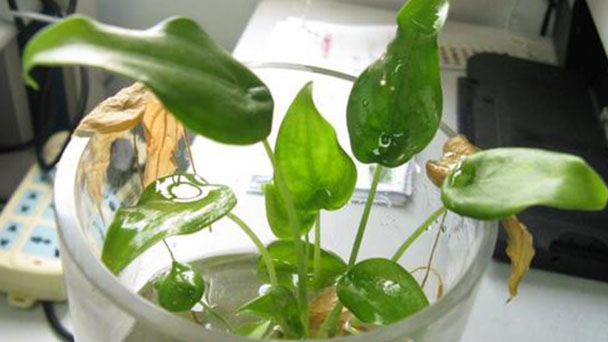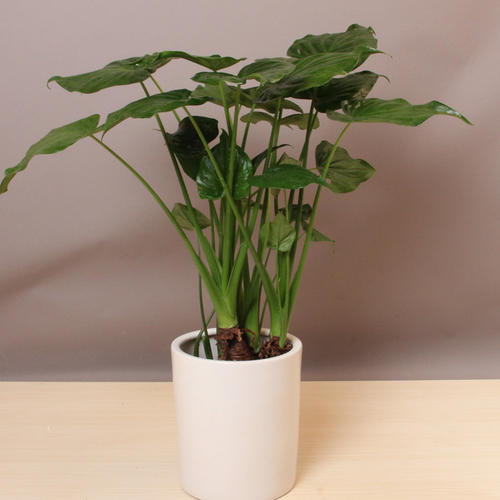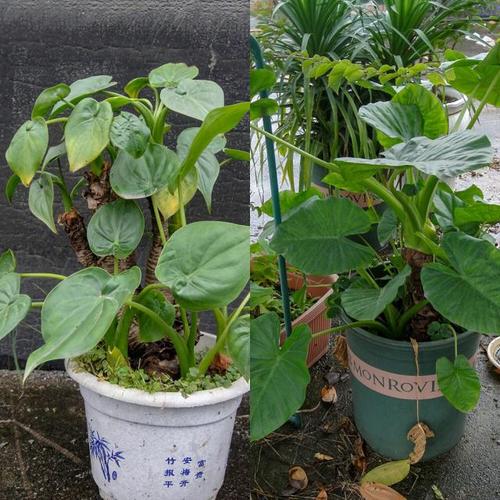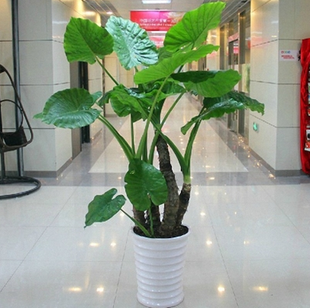Alocasia cucullata profile
Written by Maggie
Aug 24 2021

The Alocasia Cucullata is a native leaf-viewing plant of South China, Southwest China and Taiwan, and its appearance is similar to that of Dripping Guanyin, so it is often considered as a dripping Guanyin. In fact, the plant Alocasia Cucullata is shorter than that of Alocasia macrorrhizayin, which is more suitable for potted planting. The leaves are green, the roots stand erect, and the plants cluster together, making them dwarf The Alocasia macrorrhiza.
Alocasia Cucullata picture

Morphological characteristics of Alocasia Cucullata
The Alocasia Cucullata is an erect herb. The stem is cylindrical, 3-6 cm thick, dark brown, with annular leaf scars, often from the base of many shortened buds, producing new shoots, tufted. Petiole green, 25-30 (-80) cm long, strongly enlarged into a broad sheath from middle to base; The leaf blade is membranous to subleathery, dark green, dorsal slightly paler, broadly ovate-cordate, apex abruptly narrowly convex, 10-16 (-40) cm long, 7-18 (-28) cm wide, base rounded;The lateral veins of the middle rib and grade are relatively thick. The lateral veins are 5-8 pairs, of which the lower 2 pairs start from the base of the middle rib, descend, and then curve upward.Inflorescence stalks are cylindrical, slightly stout, often solitary, 20-30 cm long. The bud sub is fleshy, tube oblong-ovate, pale green to dark green, 4-8 cm long, 2.5-5 cm thick; Eaves are narrowly navicular, margin enrolled, apex long and convex, 5-10 cm long and 3-5 cm wide, upper part yellowish outside, lower part greenish. Inflorescences are shorter than flame bracts, ca. 10 cm long, female inflorescences 1.5-2.5 cm long, cylindrical, base obclate, middle 7 mm thick; Sterile male inflorescence are 2-3 cm long, ca. 3 mm thick;Male inflorescence subspindle is shaped, 3.5 cm long, 8 mm thick in the middle, pale yellow, yellow;Appendage is light green, yellowish green, narrowly conical, ca. 3.5 cm long, lower 6 mm thick.Berries are subglobose, 6-8 mm, usually seeded 1.Flowering period is in May.
Under warm, moist conditions with sufficient soil moisture, water will drip down from the tip or edge of the leaf. And flowers like Guanyin, so called Alocasia Cucullata.If the air humidity is too low, the water will immediately evaporate, so the general water droplets are more in the morning, known as the "spit" phenomenon.

Alocasia Cucullata growing environment
1. The growth temperature of alocasia cucullata is 20-30 degrees, and the lowest temperature resistance is 8 degrees. In summer, as long as the soil is kept moist, often spray water and shade, it can still grow normally, and the room temperature in winter should not be less than 5 degrees.Guanyin is the undergrowth plant of the tropical rainforest, so it needs high humidity to grow and scatter light well.
2. Alocasia cucullata is a shade tolerant plant and prefers a semi-shade environment. It should be placed in an environment that can provide shade and ventilation.
3. Alocasia Cucullata is particularly wetting, and the growing season requires not only soil moisture in the basin, but also air humidity not less than 60%. In summer, when the temperature is high, water spraying should be strengthened to create a relatively cool and humid environment. It should be placed in the indoor air-conditioned hall to ensure that the soil is moist and spray water to the foliage from time to time.If the winter room temperature can not reach 15 degrees should be controlled watering, otherwise easy to lead to rotten roots, under normal circumstances, once a week spray warm water can keep its leaf color dark green.
4. Alocasia Cucullata can be cultivated with nutrient soil prepared by wet leaf soil, peat soil, river sand and a small amount of wet cake fertilizer. It can also be hydroponics, but pay attention to rotted roots and add nutrient solution. Usually change the basin once a year in spring, and release the soil once a month to keep the basin in a good state of permeability.
5, Alocasia Cucullata is more like fertilizer, 3 to October every half moon should be applied 1 liquid fertilizer, the nitrogen element ratio can be appropriately increased, such as can add a little ferrous sulfate better so that the leaves will grow as large as lotus leaf, bright and beautiful but people. Stop fertilizing when the temperature is below 15 degrees.
The Alocasia Cucullata distribution range
Alocasia Cucullata is widely distributed in Zhejiang, Fujian, Guangxi, Guangdong, Sichuan, Guizhou, Yunnan and other places. It is below 2000 meters above sea level. It is born in gully wetlands or fields, and some places are cultivated in courtyards or drug nurseries.Bangladesh, Sri Lanka, Myanmar and Thailand also have them. Model specimens were collected from Guangzhou.

Main value of Alocasia Cucullata
Medicinal value of Alocasia Cucullata
The Alocasia Cucullata whole plant medicinal, for the treatment of snake bite medicine.Can clear heat and detoxify, reduce swelling and analgesia.Alocasia Cucullata can treat flu, high fever, tuberculosis, acute gastritis, gastric ulcer, chronic stomach disease, enteric typhoid fever, external use to treat viper bite, cellulitis, ulcer furuncle, rheumatism, etc.Fujian uses whole grass to treat baldness to come on. Alocasia Cucullata is poisonous, take it for more than 6 hours to avoid poisoning.
Ornamental value of Alocasia Cucullata
The Alocasia Cucullata is more upright. More ornamental, and the market price is also high.
Latest Updated
- Benefits of Bugleweed - 7 Science-backed Health Benefits
- Bugleweed Dangers & Side Effects - Is It Poisonous?
- How to Plant Evergreen Trees - What You Should Know
- When to Plant Evergreens - Grow Guide for Evergreen Trees
- 12 Wonderful Evergreen Shrubs for Your Garden
- 12 Popular Evergreen Plants with Pictures for Beginners
- When And How To Prune A Lilac Bush Like a Pro
- How to Grow & Care for Lilac Vine (Hardenbergia Violacea)
- Japanese Lilac Tree (Syringa Reticulata) Care & Propagation Guide
- Shumard Oak Pros and Cons - What to Know
Popular Articles
- Winter maintenance of Antirrhinum Majus
- How to Grow Terminalia Mantaly Tree
- How to Grow and Care for Crossostephium Chinense
- How to grow Antirrhinum Majus in spring
- Peristeria Elata (Dove Orchid) Profile: Info & Care Guide
- Underwatered Snake Plant (Sansevieria Trifasciata) - Signs And How To Fix
- How to Care for Brazilian Jasmine Plant (Mandevilla Sanderi)
- How to Grow & Care for Graptopetalum Purple Delight in Summer
- Rosa Chinensis (China Rose): Plant Growing & Care Tips
- How to Care for Baby Sun Rose (Aptenia Cordifolia)